Types of Dog Skin Diseases
Dog skin problems come in many forms like itchy rashes, flaky patches, bumps, or hair loss. Some are caused by allergies, others by infections or parasites. In this section, you’ll learn about the most common types of skin diseases in dogs, what they look like, and how they can be treated or managed.
Allergic Dermatitis
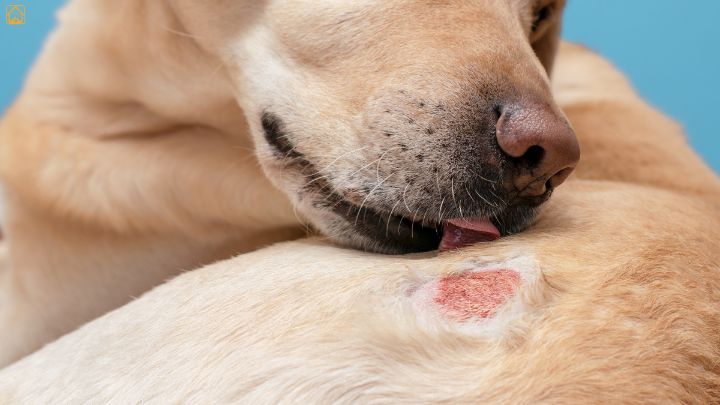
Allergic dermatitis is a common skin condition in dogs caused by an overreaction to allergens like pollen, dust, food, or flea bites. It often shows up as intense itching, redness, hair loss, or scabs, especially around the paws, ears, and belly. Some dogs may lick or scratch until the skin becomes raw or infected.
Causes include flea allergy dermatitis, environmental allergens (like pollen or mold), or food sensitivities.
Treatment usually involves antihistamines, medicated shampoos, or dietary changes, depending on the trigger.
Prevention means regular flea control, avoiding known allergens, and routine vet visits to manage flare-ups early.
Yeast Infections
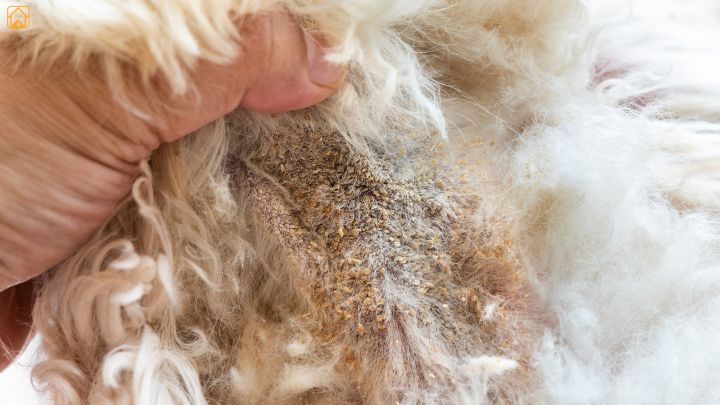
Yeast infections in dogs usually affect the skin or ears and are caused by an overgrowth of Malassezia yeast. You might notice greasy or flaky skin, strong odor, redness, constant scratching, or thickened skin especially in moist areas like ear canals, between toes, or skin folds. It’s uncomfortable but manageable with proper care.
Causes: Yeast infections often stem from underlying issues like allergies, a weakened immune system, excess moisture, or prolonged antibiotic use that disrupts skin balance.
Treatment: This usually involves antifungal shampoos, ear drops, or oral medication. Cleaning the affected area regularly is key to stopping the infection.
Prevention: Keep your dog’s skin clean and dry, especially after baths or swims. Address any allergies or underlying conditions early, and don’t skip routine vet checkups.
Bacterial Infections (Pyoderma & Folliculitis)
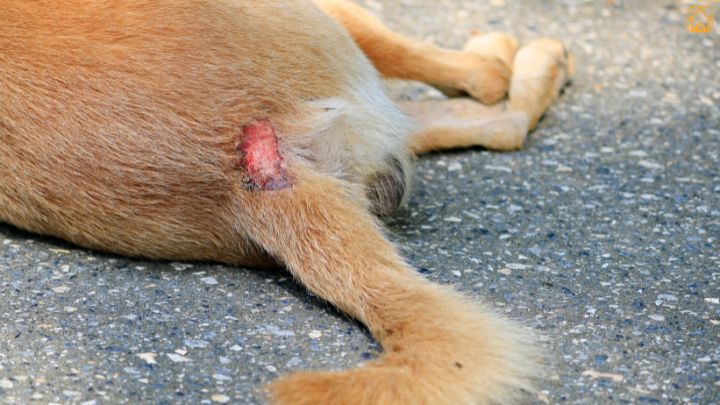
Bacterial skin infections in dogs, like pyoderma and folliculitis, often appear as red bumps, pustules, scabs, or patchy hair loss. The skin may look irritated, and your dog might lick, bite, or scratch the area constantly. Folliculitis specifically affects hair follicles, while pyoderma refers to pus-filled skin infections in general.
Causes: These infections usually occur secondary to other issues like allergies, parasites, or wounds. Moisture buildup, poor hygiene, or a compromised immune system can also contribute.
Treatment: This usually includes antibiotics (oral or topical), medicated shampoos, and treating the root cause. In mild cases, regular cleaning and topical creams may be enough.
Prevention: Keep your dog’s coat clean, dry, and well-groomed. Deal with fleas, ticks, and allergies promptly. Also, avoid letting minor cuts or rashes go untreated, as they can develop into full-blown infections.
Ringworm
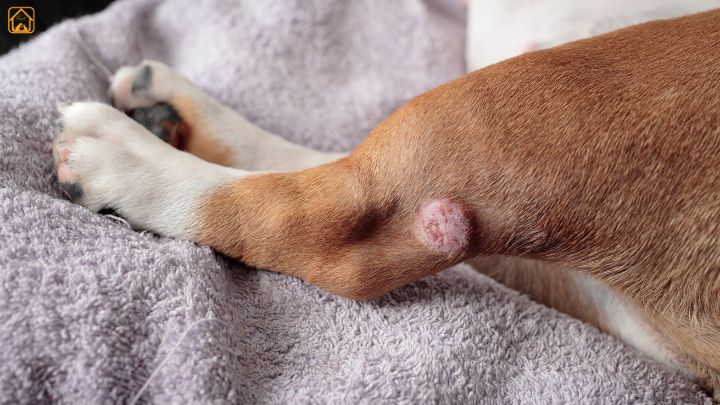
Ringworm is a contagious fungal infection that affects a dog’s skin, fur, and sometimes nails. It often shows up as circular bald patches with red, scaly edges, though some dogs may only have mild dandruff or no symptoms at all. It’s zoonotic, which means it can spread to humans and other pets.
Causes: Ringworm spreads through direct contact with an infected animal or contaminated surfaces like bedding, brushes, or floors. Puppies, senior dogs, and those with weak immune systems are more at risk.
Treatment: Treatment usually involves antifungal shampoos, ointments, and oral medications for severe cases. Your vet may also recommend shaving the affected area and disinfecting your home thoroughly.
Prevention: Regular grooming, cleaning, and avoiding contact with infected animals can help. If your dog gets ringworm, isolate them during treatment and disinfect their environment to stop the infection from spreading.
Mange (Mites)

Mange is a skin condition caused by microscopic mites that burrow into or live on a dog’s skin. It leads to intense itching, hair loss, scabs, and sometimes skin infections. The two main types are sarcoptic mange (highly contagious and very itchy) and demodectic mange (usually affects puppies or dogs with weak immunity).
Causes: Mange spreads through direct contact with infected dogs, wildlife, or contaminated objects. Sarcoptic mange is especially contagious. Demodectic mange often arises when the dog’s immune system fails to control naturally occurring mites.
Treatment: Vets usually prescribe medicated shampoos, oral or topical anti-parasitic medications, and antibiotics if secondary infections develop. Treating all pets in the home may be necessary in contagious cases.
Prevention: Avoid contact with infected animals and keep your dog’s bedding and living area clean. Regular vet checkups help catch skin problems early before they spread or worsen.
Seborrhea
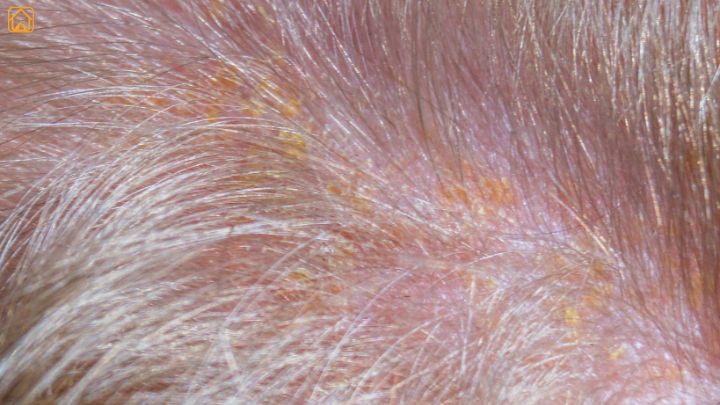
Seborrhea is a skin condition that causes greasy, flaky, or scaly skin, often with a strong odor. It can affect any part of the body but usually shows up on the back, face, and flanks. Some dogs have dry flakes (seborrhea sicca), while others have oily, greasy skin (seborrhea oleosa). Many show a mix of both.
Causes: It can be primary (genetic, common in breeds like Cocker Spaniels and Basset Hounds) or secondary to issues like allergies, hormonal imbalances, poor diet, or infections. Secondary seborrhea is more common and usually signals an underlying health problem.
Treatment: Managing seborrhea depends on the cause. Medicated shampoos, antifungal or antibacterial treatments, and dietary adjustments are often used. If it’s secondary, the underlying issue must be addressed for long-term relief.
Prevention: You can’t always prevent genetic cases, but regular grooming, a healthy diet, and managing allergies or infections early can reduce flare-ups and keep your dog’s skin healthier.
Hot Spots (Acute Moist Dermatitis)
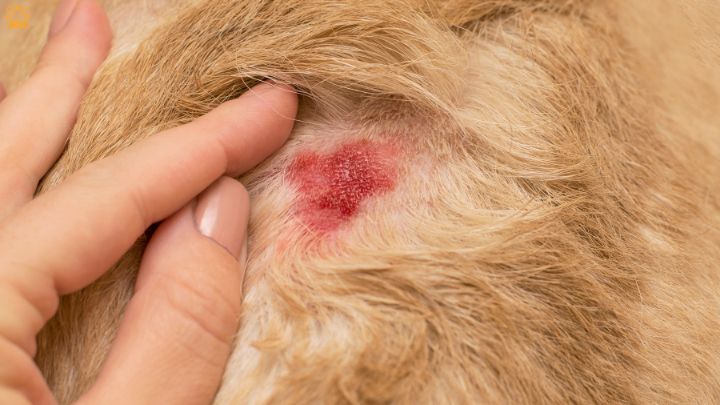
Hot spots are red, inflamed, and often oozing patches of skin that appear suddenly and worsen quickly. They’re painful, itchy, and can grow fast if your dog keeps licking, scratching, or biting the area. Commonly found on the head, hips, or chest, hot spots can be alarming but are treatable.
Causes: Hot spots are usually triggered by something that irritates the skin like fleas, allergies, insect bites, poor grooming, or even boredom and stress. Once the dog starts scratching or licking, the spot gets worse and invites infection.
Treatment: The area is typically shaved and cleaned to stop the infection from spreading. Your vet may prescribe antibiotics, anti-itch medications, or topical creams to soothe the skin and prevent further damage. Keeping your dog from licking the spot is key to healing.
Prevention: Regular grooming, flea control, and keeping your dog mentally stimulated can help reduce the risk. Spotting skin irritations early also prevents them from becoming full-blown hot spots.
Crusty Dog Skin Conditions
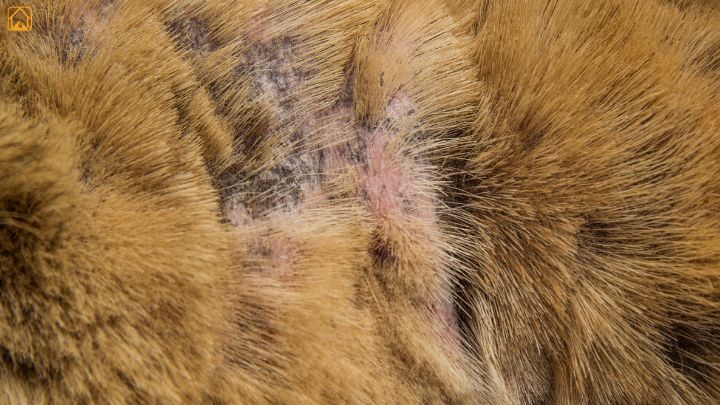
Crusty skin in dogs often shows up as scabs, flakes, or rough patches that may feel dry or irritated to the touch. It can appear anywhere on the body and might be accompanied by itching, redness, or even hair loss. These patches are usually signs of an underlying skin problem.
Causes: Crusty skin can be caused by a range of issues parasites like mites or fleas, fungal or bacterial infections, allergies, poor nutrition, or even autoimmune diseases. Sometimes, it’s due to excessive scratching from another underlying condition.
Treatment: The right treatment depends on the cause. Your vet might suggest medicated shampoos, antibiotics, antifungals, or anti-parasitic medications. In cases related to allergies, a change in diet or medication may help manage the symptoms.
Prevention: Keep your dog clean and groomed, maintain a balanced diet, and regularly check for fleas or signs of skin trouble. Early vet visits help catch problems before they worsen.
Tumors, Growths, and Warts
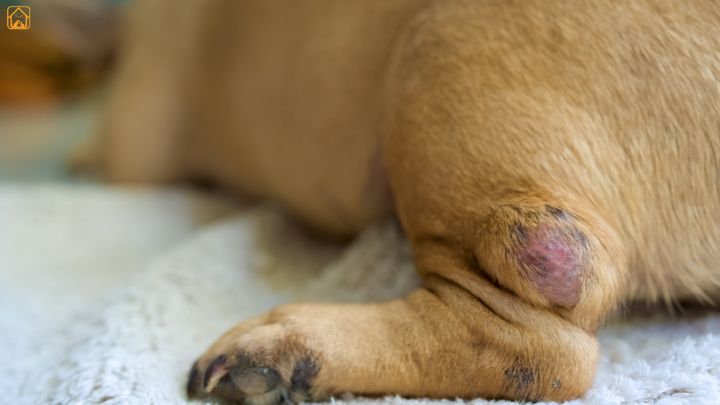
Lumps and bumps on your dog’s skin can be scary, but not all are dangerous. Some are harmless fatty tumors (lipomas), while others may be warts, cysts, or more serious cancerous growths. They can vary in size, shape, texture, and how fast they grow.
Causes: These growths may be caused by aging, viruses (like papillomavirus for warts), genetics, or exposure to harmful substances. Some breeds are more prone to certain tumors.
Treatment: Treatment depends on the type. Benign lumps may not need removal unless they interfere with movement or grow rapidly. Suspicious or cancerous tumors usually need surgical removal and possibly chemotherapy or radiation, based on the diagnosis.
Prevention: You can’t always prevent growths, but regular home checks and vet visits help catch them early. Keep your dog on a healthy diet and avoid exposure to toxins or harmful chemicals whenever possible.
Dry, Flaky Skin
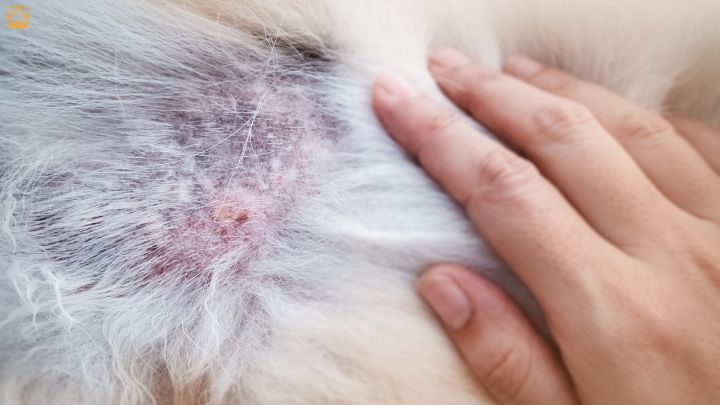
Dry, flaky skin in dogs can show up as dandruff, itchiness, or rough patches. It often makes dogs uncomfortable and may lead to scratching or licking. While sometimes seasonal, it can also signal an underlying issue like poor diet, allergies, or a skin condition.
Causes: Common causes include low humidity, nutritional deficiencies (especially lack of omega-3 fatty acids), allergies, frequent bathing with harsh shampoos, or conditions like seborrhea and hypothyroidism.
Treatment: Treatment depends on the root cause. Moisturizing shampoos, dietary changes, omega-3 supplements, and medicated sprays can help. If it’s due to an underlying condition like allergies or thyroid issues, your vet will prescribe specific treatment.
Prevention: Keep your dog’s skin hydrated with regular brushing and occasional use of moisturizing products. Feed a balanced diet rich in healthy fats and avoid overbathing. Keep an eye on any skin changes, especially in dry seasons.
Skin Issues Related to Underlying Conditions
Some skin issues in dogs point to deeper health problems. If you’ve heard about “skin issues in dogs with Cushing’s” or “thyroid skin issues in dogs,” you know these conditions can sneak up quietly.
Cushing’s Disease
Cushing’s disease, or hyperadrenocorticism, causes the body to produce too much cortisol. One of the early signs is poor skin and coat health. Dogs may develop thin, fragile skin, hair loss, dark spots, or slow-healing wounds.
Causes: It’s usually caused by a tumor on the pituitary or adrenal glands.
Treatment: Treatment may involve medication to control cortisol levels, or surgery if a tumor is involved. Regular bloodwork is essential.
Prevention: There’s no guaranteed prevention, but early diagnosis and consistent vet care help manage the condition and reduce skin complications.
Kidney Disease
Kidney disease doesn’t just affect internal organs, it can show up on the skin too. Dogs may develop dryness, itchiness, bad odor, or even ulcers in severe cases. Toxins that build up in the blood can trigger these skin reactions.
Causes: Chronic kidney failure, toxins, infections, or age-related decline.
Treatment: Supportive care like IV fluids, a special kidney diet, and medications to lower toxin buildup.
Prevention: Regular blood tests, hydration, and early detection are key. Keep dogs away from harmful substances like grapes, raisins, and certain meds.
Hypothyroidism (Low Thyroid Hormones)
When the thyroid slows down, the skin and coat suffer. Dogs with hypothyroidism often have dry, flaky skin, excessive shedding, bald patches, and a dull coat. Some develop thickened or darkened skin.
Causes: It’s usually an autoimmune condition or related to aging.
Treatment: Daily thyroid hormone pills are effective. Skin and coat improve once hormone levels are balanced.
Prevention: You can’t always prevent it, but spotting signs early and getting bloodwork done helps with fast treatment and avoids long-term skin damage.
Autoimmune Disorders
Autoimmune diseases in dogs, like lupus or pemphigus, cause the immune system to attack healthy skin. This leads to ulcers, crusting, inflammation, and even open sores especially around the nose, paws, or ears.
Causes: Exact causes are unknown but may involve genetics, stress, or environmental triggers.
Treatment: Immunosuppressive drugs, antibiotics for secondary infections, and special care for wound healing.
Prevention: These disorders can’t be fully prevented, but flare-ups can be reduced by managing stress, avoiding sun exposure, and staying consistent with vet-prescribed treatment plans.
If your dog’s skin problems don’t improve with usual treatment, or if you see signs like sudden hair loss, skin color changes, or crusty patches, talk to your vet about possible underlying diseases.
Dog Skin Issues: Symptoms & Early Signs
When it comes to skin issues in dogs, the first clues are often easy to miss. But if you know what to look for, you’ll catch problems before they turn into bigger headaches, for both you and your dog.
Common Early Symptoms
- Itching, scratching, or licking more than usual
- Red or inflamed skin
- Hair loss or bald patches
- Scabs, crusts, or flaky skin
- Bumps, lumps, or open sores
- Unusual odor coming from your dog’s skin or coat
- Scaly or greasy patches
- Discoloration (dark or light spots)
What Causes Skin Issues in Dogs?
Skin issues in dogs can feel like a mystery, but there are a few usual suspects. Knowing what causes skin issues in dogs can help you and your vet track down the root problem.
Top Causes of Dog Skin Problems
- Allergies: Dogs can react to food, pollen, dust mites, mold, or even flea bites. Allergic dermatitis is a major cause of itching and rashes.
- Parasites: Fleas, ticks, and mites (like mange) can cause relentless scratching and secondary infections.
- Infections: Bacterial, fungal, and yeast infections lead to red, inflamed, or crusty skin. Ringworm (a fungus, not a worm!) is common in puppies.
- Hormonal Disorders: Conditions like hypothyroidism or Cushing’s disease disrupt the skin’s balance, leading to hair loss and recurrent infections.
- Environmental Factors: Dry air, harsh shampoos, or irritants can dry out skin and damage the coat.
- Genetics: Some breeds are just more prone to skin and coat issues, Bulldogs, Retrievers, and Terriers, for example.
- Autoimmune Conditions: Rare, but can trigger the immune system to attack healthy skin cells.
Ever found yourself asking, “Can worms cause skin issues in dogs?” Surprisingly, the answer is yes. Internal parasites can sometimes lead to skin symptoms, especially if your dog’s immune system is stressed.
Diagnosing Dog Skin Problems: When and How to Seek Help
It’s tough to tell when a skin problem is minor or a sign of something serious. But here’s the thing, if your dog has ongoing symptoms or anything looks infected, it’s time for a professional opinion.
When to See the Vet
- Persistent itching or licking (more than a few days)
- Open sores, bleeding, or oozing
- Hair loss in patches or all over
- Crusty, thickened, or darkened skin
- Lumps, bumps, or growths that change size
- Signs of pain or your dog acting sick
Skin Issues in Dogs: Treatment Options (Conventional & At-Home Remedies)
Once you’ve got a diagnosis, treating skin issues in dogs usually means a mix of vet-prescribed treatments and some at-home. Here’s how to treat dog skin disease at home and what to expect from your vet.
Conventional Treatments
- Medicated Shampoos: For yeast, bacteria, or seborrhea; use as directed by your vet
- Topical Creams and Sprays: Steroids, antifungals, or antibiotics for localized issues
- Oral Medications: Antibiotics, antifungals, or immune-suppressants for infections and autoimmune problems
- Flea/Tick Preventives: Essential for parasite-related skin conditions
- Allergy Meds: Antihistamines, cytopoint injections, or prescription diets
- Ivermectin: Used for certain types of mange, but never give without a vet’s guidance (some breeds can’t tolerate it!)
At-Home Remedies & Support
- Oatmeal baths: Soothe itchy, inflamed skin (but avoid open wounds)
- Coconut oil: Moisturizes dry or flaky skin, apply a thin layer or mix in food (check with your vet first)
- Fatty acid supplements: Omega-3s support skin healing and coat health
- Melatonin: Sometimes recommended for alopecia X or to help manage itching, but always ask your vet
- Keep the area clean and dry: Gently wash minor rashes with mild, dog-safe cleansers
Here’s the weird part, sometimes, what looks like a simple rash is actually the tip of the iceberg. So never ignore even a small rash.
Preventing Skin and Coat Issues: Nutrition, Grooming & Lifestyle Tips
Prevention beats cure, especially when it comes to skin and coat issues in dogs. The good news? A few routine habits can make a huge difference.
Nutrition for Healthy Skin
- Feed a balanced, high-quality dog food with plenty of protein and omega-3 fatty acids
- Consider supplements like fish oil (with your vet’s approval)
- Make sure your dog always has fresh water
Grooming Tips
- Brush regularly to remove loose fur and distribute natural oils
- Bathe as needed, but not too often, overbathing strips the skin’s protective barrier
- Use gentle, dog-specific shampoos, avoid products with sulfates or harsh chemicals
Lifestyle and Environment
- Keep bedding, toys, and your home clean to reduce allergens and parasites
- Watch for seasonal changes, dry air in winter can lead to flakiness
- Minimize stress, since anxiety can trigger licking and chewing
Honestly, one of my favorite routines is a quick coat check during cuddle time. It’s a chance to spot early changes.
Common Mistakes and Myths About Dog Skin Care
Sometimes, what we think is helping actually makes things worse. Here are a few myths and mistakes I hear all the time:
- Myth: Human shampoos are fine for dogs.
- They can disrupt your dog’s skin pH and cause irritation!
- Myth: All skin issues are allergies.
- Many are infections or hormone-related
- Myth: Only dirty dogs get skin diseases.
- Clean dogs can get them too, genetics and environment matter
- Mistake: Ignoring persistent scratching, if it lasts more than a few days, see a vet
- Mistake: Using home remedies without a diagnosis, some can make infections worse
You know what’s funny? I used to think coconut oil fixed everything. Turns out, it helps some dogs, but for others, it just made them greasy.
Conclusion
Dog skin issues are more than just a surface problem they often signal something deeper. Early signs like itching, redness, or hair loss shouldn’t be ignored. With proper care, vet guidance, and a little attention at home, most skin problems can be managed well, keeping your dog healthy, happy, and itch-free.



